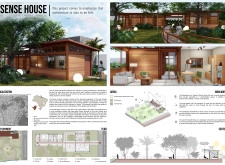5 key facts about this project
At the heart of the Sense House is the concept of engaging the senses in a meaningful way. Each design element contributes to an immersive experience that allows residents to feel their surroundings deeply. The layout of the house is organized into distinct areas, each serving a specific purpose while maintaining an open flow between them. This organization fosters a sense of community in the social areas while providing spaces of solitude in more intimate rooms. The carefully planned spatial arrangement invites movement and encourages exploration, enhancing the resident's engagement with the home.
Materiality plays a crucial role in the overall design philosophy of the Sense House. The use of wood, concrete, rammed earth, glass, and limestone creates a tactile experience that resonates with the natural surroundings. Wood offers warmth and a connection to traditional craftsmanship, while concrete provides structural integrity and durability. Rammed earth adds an authentic, earthy feel to the design, supporting sustainable practices and promoting thermal comfort. The extensive use of glass welcomes natural light and blurs the boundaries between indoors and outdoors, allowing residents to immerse themselves in the beauty of the landscape. Limestone further emphasizes the connection to nature, seamlessly blending the house with its site and providing a cohesive aesthetic.
One of the most prominent features of the Sense House is its integration with the existing landscape, particularly through the incorporation of the Sangradoro Stream. This natural element not only enhances the aesthetic appeal of the property but also adds a unique auditory experience, as the sound of flowing water contributes to a calming atmosphere. The strategic placement of windows and terraces ensures that residents can enjoy views of the stream and the surrounding garden, which play a vital role in the project's design approach.
The pathway throughout the site is designed to facilitate exploration and interactivity, encouraging residents and visitors to experience the various aspects of the landscape. This winding path serves as a connective element, guiding individuals through the garden and drawing attention to different areas of interest, further enriching the sensory experience of the home.
Sustainability is another key consideration in the architecture of the Sense House. The project employs geothermal energy solutions to regulate indoor temperatures effectively, reducing reliance on external energy sources. Additionally, the design embraces universal accessibility, ensuring that the home can be enjoyed by individuals of all abilities.
The Sense House’s unique design approaches demonstrate a balance between aesthetic appeal, functionality, and environmental responsibility. This project invites exploration and promotes well-being, allowing residents to develop a deeper relationship with their living environment. To gain further insights into the architectural plans, sections, and diagrams that elucidate this thoughtful design, readers are encouraged to delve into the project's detailed presentation. The Sense House illustrates how architecture can create spaces that foster connections, nurture the spirit, and celebrate the beauty of the natural world.























